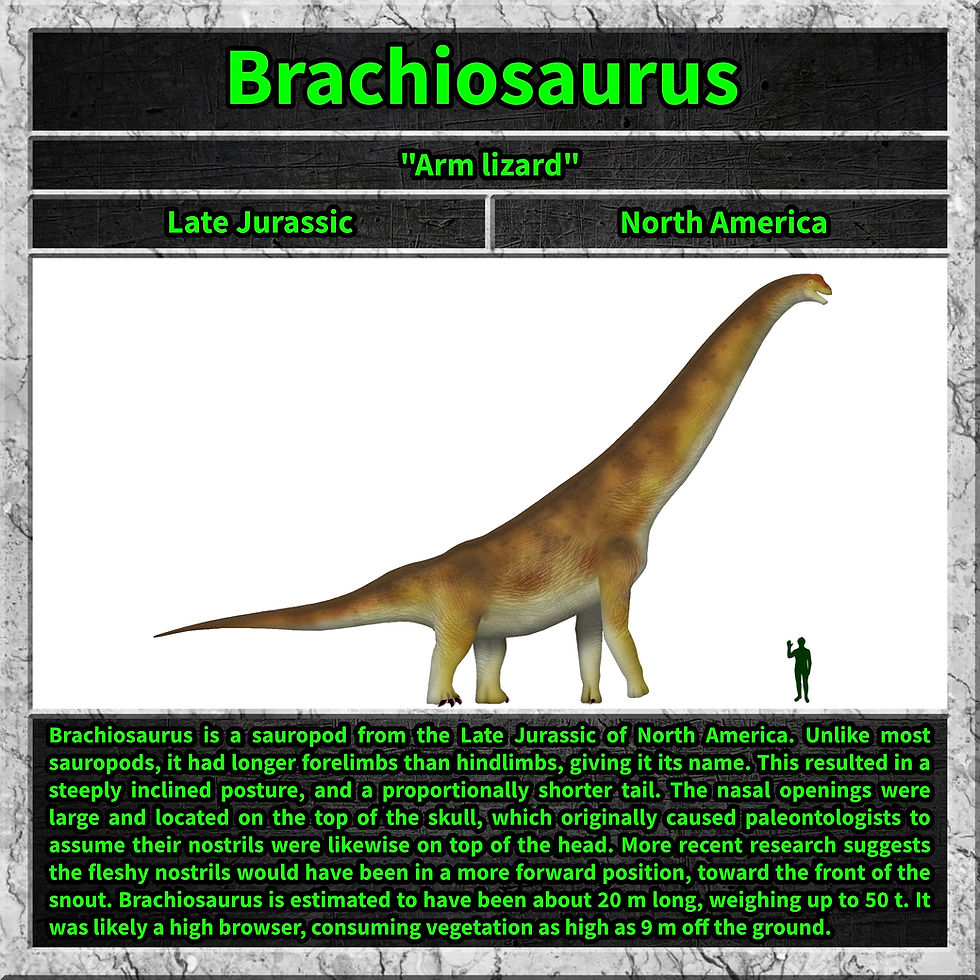Diplodocus
- unexpecteddinolesson
- Oct 15, 2023
- 2 min read
Updated: May 4
MEANING: Double beam
PERIOD: Late Jurassic
CONTINENT: North America
Diplodocus is one of the best-known sauropod dinosaurs, with its long neck and tail, and pillar-like legs. It could reach up to 25 m in length, and it weighed about 15 t. Diplodocus had a horizontal posture, and most likely browsed at low levels. This helped to avoid competition with its contemporary Camarasaurus, which held its neck more vertically.

Diplodocus is from the Late Jurassic. The Late Jurassic was a dynamic period, spanning from about 162 to 143 million years ago. The continents were continuing to drift apart, and the supercontinent Pangaea had fully split into Laurasia in the north and Gondwana in the south. This continental rearrangement led to the formation of large inland seas and shallow coastlines that fostered diverse ecosystems. The climate during the Late Jurassic was warm and humid, with lush forests of conifers and ferns that stretched across much of the continents, creating a rich ecosystem where dinosaurs flourished the dominant land animals.
Dinosaurs continued to diversify through the Late Jurassic, with some of the most famous species evolving in this time. Many well-known sauropods, such as Brachiosaurus and Apatosaurus roamed the land, exhibiting niche partitioning with their selectively distinct neck positions. Alongside them, stegosaurs became widespread, their plates and spikes making them one of the era's most recognizable groups. Theropods like Allosaurus and Ceratosaurus were the apex predators, evolving large, powerful bodies and sharp teeth that allowed them to hunt the gigantic herbivores. The early evolution of birds was taking place, setting the stage for the numerous species that would fill the skies in the eras to come.
Unlike the dramatic mass extinctions that marked the beginning and end of the Mesozoic, the Jurassic Period ended without a sharp boundary. As the continents continued to drift, ecosystems gradually transformed into unique habitats that supported the more specialized dinosaur species of the Cretaceous.

Diplodocus is a sauropod. Sauropods are saurischian dinosaurs that had very long necks, long tails, small heads (relative to the rest of their body), and four thick, pillar-like legs. They are notable for the enormous sizes attained by some species, and the group includes the largest animals to have ever lived on land. Well-known genera include Brachiosaurus, Diplodocus, Apatosaurus and Brontosaurus.
The oldest known unequivocal sauropod dinosaurs are known from the Early Jurassic, and by the Late Jurassic (150 million years ago), sauropods had become widespread. By the Late Cretaceous, one group of sauropods, the titanosaurs, had replaced all others and had a near-global distribution. This group included the largest animals ever to walk the earth. Estimates vary, but the largest titanosaurs are estimated at upward of around 40 m, and weighing 100 t, or possibly even more.
As with all other non-avian dinosaurs alive at the time, the titanosaurs died out in the Cretaceous–Paleogene extinction event. Fossilized remains of sauropods have been found on every continent, including Antarctica.




